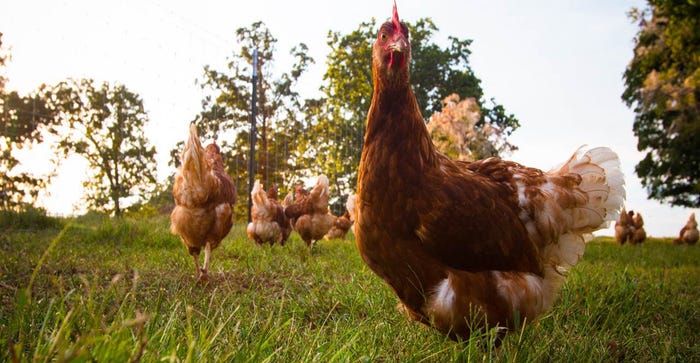New Food Order: Defining and Scaling Regenerative Agriculture
In the 17th episode, panelists explore how to help farmers transition to regenerative agriculture while addressing climate change and supply chain issues.
May 3, 2023

Regenerative agriculture is more important than ever.
As the food industry moves into more sustainable practices to mitigate climate change, implementing regenerative practices to build more resilient ecosystems has become a burgeoning trend.
It’s about renewing the land, by farming, ranching and creating a food system in a holistic manner within nature. While regenerative agriculture looks to improve soil health and increase biodiversity, its meaning isn’t synonymous. That can make defining it complicated.
“One of my board members often calls it ‘farming in the service of life,’” says Elizabeth Whitlow, executive director at the Regenerative Organic Alliance. “And I really love that.”
Reginaldo Haslett-Marroquin, founder of the Regenerative Agriculture Alliance, says, “It’s simply how the earth’s ecosystems operate and we respect that.”
From Haslett-Marroquin’s indigenous point of view, regeneration is the transformation of energy, the flow and diversity of life that has sustained all living organisms on the planet to collectively thrive for thousands of years.
“The health of us, as human beings, depends 100% on the health of all of the other living systems,” Haslett-Marroquin says.
In this episode of New Food Order, a podcast investigating the business of tackling climate and social crises through food and agriculture, Louisa Burwood-Taylor, the head of media research at AgFunder and editor of AgFunder News, and Danielle Gould, the founder of Food+Tech Connect, host a roundtable discussion about how to define and scale regenerative agriculture.
Understand the uniqueness of a place
Regenerative agriculture is about “how we nurture and feed” the complex natural, human, social, cultural and economic systems, says Daniela Ibarra-Howell, CEO of Savory Institute.
It’s also about understanding the uniqueness of a place to ensure practices that are imposed on farmers make sense. “It’s believing in the local knowledge,” she says. “To unleash the unrealized potential of those systems.”
From a corporate perspective, she says, it’s about having agriculture that produces “ecological net positive outcomes.”
Follow the money
Investors need to consider what their money is doing to help regenerative practices.
“I see many investors asking, ‘Is this a regenerative approach,’ or ‘Is this a regenerative farmer?’” says Koen van Seijen, a senior manager at Toniic, a global community of impact investors, and host of Investing in Regenerative Agriculture podcast. “And I don’t think it’s the right question to ask.”
Instead, it’s better to understand if the soil is being improved and answer, “Is the place becoming more alive?” van Seijen says.
That means seeing improvements in land’s biodiversity, carbon sequestration, water storage and growth of topsoil as well as the health of people within an interconnected ecosystem.
“When a place becomes more alive, we are part of that,” van Seijen says. “But many people don’t see it that way, which is a bit troublesome.”
Reducing the use of agricultural inputs
With skyrocketing prices and the war in Ukraine, producers, retailers and consumers are paying more attention to what’s being imported and shipped.
That’s created a downward spiral for many conventional farmers who have become reliant on imported chemical inputs. “For many farmers and ranchers, who were already at the edge, these input prices pushed them over,” van Seijen says.
That’s forced many farmers and ranchers into transition plans. “Which is horrible,” he says. “Being completely dependent on an input system with very thin margins is asking for trouble.”
Designing the right systems
Both Whitlow and Gould stress the importance of bringing regenerative agriculture to market, engaging more consumers who can support the movement and creating food systems that reward farmers for implementing regenerative practices.
“Cheap food is never cheap,” Whitlow says. “It always comes at a cost, to the people who find that food and people who eat that food.”
Financing needs to support farmers, instead of trying to extract value, Ibarra-Howell says. That means designing finance, policy, supply chains, value networks and supply webs that can foster regenerative farmers and food producers, Ibarra-Howell says.
Like “peeling the layers of an onion,” that requires working in different layers, Ibarra-Howell says, to overhaul the current framework.
“It’s a huge challenge because we have to undo what has been done and recreate it,” she says. “I don’t think we can patch the system. We need to break it apart.”
Ibarra-Howell says creating systemic change requires the food system to become more localized, more relational and more conscientious. Many global companies and shareholders that back the current food systems are disconnected from how food is grown.
“There’s no quick fix, no silver bullet,��” Ibarra-Howell says. “It starts with having different conversations, which a lot companies are wanting to have because they have to reinvent themselves if they are going to create the impact they are seeking, or disappear, which in many cases, will happen.”

The poultry push
One potential solution is a farmer-driven model like Haslett-Marroquin’s Minnesota-based nonprofit, Regenerative Agriculture Alliance, which focuses on poultry for its regenerative agriculture.
Chickens are a strong entry point into creating a larger, more sustainable food system, Haslett-Marroquin says, because improving the soil and leveraging the photosynthesis in plants is almost “completely dependent” on the livestock.
That trifecta—using the right animals, soil and plants together—helps draw down carbon and improve water retention, crop resilience and nutrient density. “If you remove the animals, the other two pretty much stop or slow down to such a level that ecosystems don’t regenerate,” he says.
Many farmers may not have the space or the funds to secure large livestock. Engaging small farmers, who produce much of the world’s food—the percentage is a matter of debate among experts—on less than 25 acres of land, requires utilizing more manageable livestock, like chickens.
“It’s got the shortest lifecycle, it’s a universal healthy protein source,” Haslett-Marroquin says. “It’s the food of the poor across the world.” Regenerative Agriculture Alliance starts by helping Midwestern farmers put chickens back into their natural “jungle-like” environment. That means planting hazelnuts and elderberries that are native to two-thirds of the continental U.S., Haslett-Marroquin says. Then, add in overstory trees—tall trees with massive canopies—that are native to the region, including pine, maple or oak trees. “On the bottom of all that, you’ll raise the chickens in their natural environment,” he says.
The land, which is managed by the nonprofit in Wisconsin, Minnesota and Iowa, is now being transitioned to include alley cropping, where rotational crops are planted between rows of trees. The nonprofit now includes the first worker-managed poultry processing facility in the country, in Stacyville, Iowa, Haslett-Marroquin says, “so there is no exploitation of workers.”
For similar models to work, Haslett-Marroquin says, they need to be structured as a nonprofit so “everybody makes a decent living, but profit isn’t the motive.”
Driving awareness
More needs to be done to educate the public about the importance of regenerative agriculture and celebrate natural products that source bio-nutrient ingredients.
One simple way is using a label or logo on a product. It’s a concept Regenerative Organic Alliance already employs with its Regenerative Organic Certified (ROC) to call-out farmers who are implementing regenerative practices.
That helps consumers who want to shop based on their values, Whitlow says. It’s a “gross oversimplification of this beautiful concept,” she says, “but how else are we going to drive that awareness and that change?”
Listen and subscribe to the podcast here.
About the Author
You May Also Like




